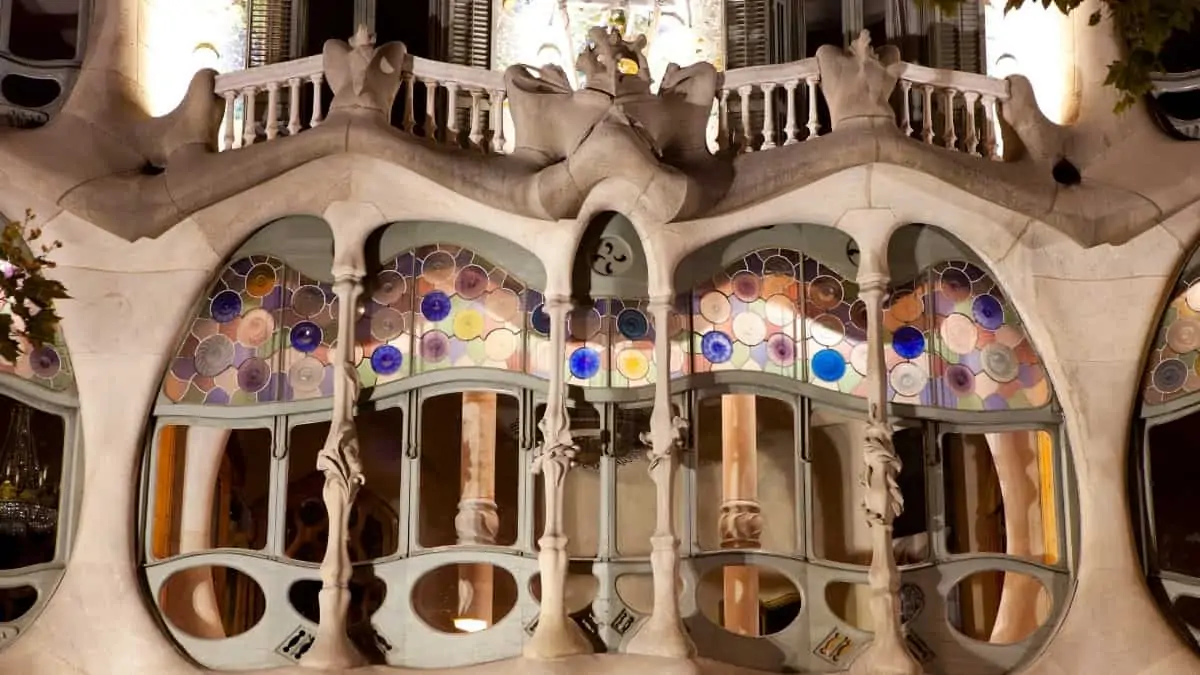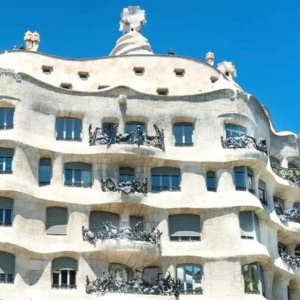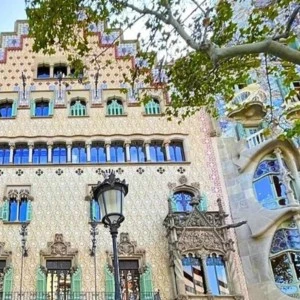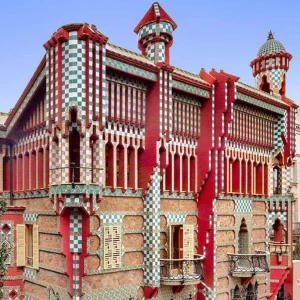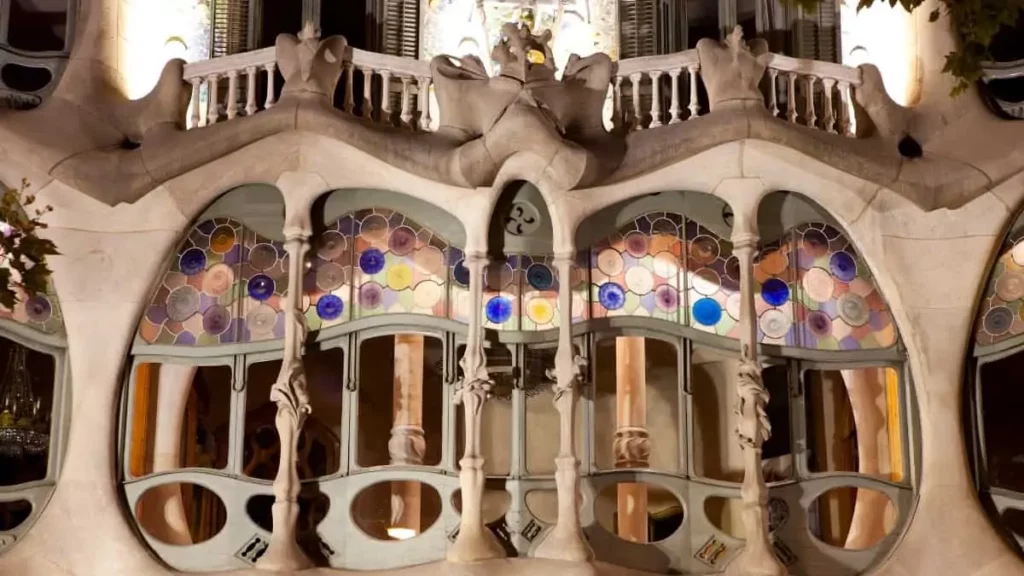
Casa Batllo is a beautiful residential building that receives about one million visitors each year.
Catalan architect Antoni Gaudí, who built Sagrada Família, Park Guell, Casa Mila, etc., designed this attraction more than 110 years ago.
The locals also call it Casa dels Ossos, or House of Bones, due to its facade featuring skull-like balconies and bone-shaped columns.
This article shares everything you need to know before buying your Casa Batllo tickets.
Top Tickets
# Casa Batllo Standard Tickets
# Casa Batllo & Casa Mila
# Best of Barcelona BundleIt’s highly recommended to book your Casa Batllo tickets in advance. These tickets sell out quickly, so securing your spot early ensures you don’t miss out on this unforgettable experience.
What’s ahead
Where to buy tickets and how do they work?
Related Reads
You can purchase Casa Batllo tickets online, which are usually more affordable than purchasing on-site.
Booking online and in advance not only helps you skip the long queues at the ticket counters but also allows you to choose your preferred time slot and avoid last-minute disappointment.
Your tickets are delivered to your email and you can show them on your phone upon arrival – no need for printouts.
Arrive at least 10 minutes before your scheduled entry time.
Casa Batllo tickets
Casa Batllo offers four levels of tickets, Blue ticket (Standard), Silver ticket (Upgraded), Gold ticket (Premium), and Platinum ticket (VIP), each offering different experiences.
| Feature | Blue | Silver | Gold | Platinum |
|---|---|---|---|---|
| Audio guide | ✅ | ✅ | ✅ | ✅ |
| Gaudí Cube (360º) | ✅ | ✅ | ✅ | ✅ |
| Dragon’s Rooftop | ❌ | ✅ | ✅ | ✅ |
| Augmented Reality Tablet | ❌ | ❌ | ✅ | ✅ |
| Gaudí Dôme (Immersive Experience) | ❌ | ❌ | ✅ | ✅ |
| Original Concierge Room | ❌ | ❌ | ✅ | ✅ |
| Private Residence of the Batllós | ❌ | ❌ | ✅ | ✅ |
| Priority Pass (Skip the Line) | ❌ | ❌ | ❌ | ✅ |
| Flexible Date Change | ❌ | ❌ | ❌ | ✅ |
| Free Cancellation | ❌ | ❌ | ❌ | ✅ |
You can book these tickets for the daytime slots (9 am to 6.15 pm) or the night time slots (6.30 pm to 8.45 pm). Each visit lasts 75 minutes.
All tickets for night time slots include scenography and projections, which is why they are €10 more than the day time tickets.
From March to October, Casa Batllo’s night tours which start at 6.30 pm are called ‘Magical Nights’ and rest of the year ‘A Winter Night.’
Every entry ticket includes Casa Batllo’s SmartGuide, which is an audio guide combined with augmented reality technology.
Tourists who visit at night can choose the voice for their SmartGuide experience – between Fermina, the Batllo family’s caretaker, or Juan Carlos, a descendant, for a first-person journey through the house.
Kids up to 12 years can enter Casa Batllo for free.
Standard tickets (Blue)
The Standard Casa Batlo tickets are the cheapest and most popular way to explore Antonio Gaudi’s residential creation.
Once at the attraction, you can take the ‘Blue & Agencies’ lane and show your ticket on your mobile to get in.
This ticket includes entry, the audio guide and also access to Gaudi Cube (360). However, it doesn’t let you skip any queues inside the attraction, you don’t have the VR tablet and there is no access to the rooftop.
Daytime ticket price
Adult (18 to 64 years): €35
Youth (13 to 17 years): €29
Student (with ID): €29
Senior (65+ years): €32
Nighttime ticket price
Adult (18 to 64 years): €45
Youth (13 to 17 years): €39
Student (with ID): €39
Senior (65+ years): €42
Related: Guide to visiting the Sagrada Familia
Upgraded Entrance Ticket (Silver)
Over and above what the Standard ticket gets you, the Upgraded ticket also allows you to enter Dragon’s rooftop.
This upgraded entrance ticket holders must take the Silver lane.
Daytime ticket price
Adult (18 to 64 years): €40
Youth (13 to 17 years): €34
Student (with ID): €34
Senior (65+ years): €37
Nighttime ticket price
Adult (18 to 64 years): €50
Youth (13 to 17 years): €44
Student (with ID): €44
Senior (65+ years): €47
Find out which is better: Casa Mila or Casa Batlló?
Premium Entrance Ticket (Gold)
With the Premium tickets, you get VIP entry to Casa Batllo. The other inclusions are:
Access to Gaudí Cube (360º)
Augmented reality tablet
Access to the Batlló concierge room
Access to Dragon’s rooftop
Access to Gaudí Dome (immersive)
Access to the Batlló private residence
With the Augmented Reality tablet, visitors can see how the different looked in Gaudí’s time, and watch the sea creatures, nature, and colors that influenced his designs etc.
That’s why we highly recommend the Premium Ticket if you’re visiting with kids.
Daytime ticket price
Adult (18 to 64 years): €45
Youth (13 to 17 years): €39
Student (with ID): €39
Senior (65+ years): €42
Nighttime ticket price
Adult (18 to 64 years): €55
Youth (13 to 17 years): €49
Student (with ID): €49
Senior (65+ years): €52
All-Inclusive Entrance Ticket (Platinum)
Besides everything that’s on offer in the Premium (Gold ticket), in Casa Batllo’s Platinum ticket you get to skip all lines with the Priority Pass and also cancel your tickets up to three hours before your visit.
If your plans might change, we recommend this ticket.
Daytime ticket price
Adult (18 to 64 years): €55
Youth (13 to 17 years): €49
Student (with ID): €49
Senior (65+ years): €52
Nighttime ticket price
Adult (18 to 64 years): €65
Youth (13 to 17 years): €59
Student (with ID): €59
Senior (65+ years): €62
Best of Barcelona Bundle grants access to top attractions like Sagrada Familia, Park Guell, and Casa Batllo. It also offers a 10% discount on a future booking.
Recommended
Casa Batllo combos
Book these tickets for a seamless experience, combining Barcelona’s top must-see attractions in one convenient package.
| Casa Batllo + Casa Mila | €60 |
| Casa Batllo + Park Guell | €53 |
| Casa Batllo + Sagrada Familia | €65 |
| Casa Batllo + Casa Vicens | €60 |
| Casa Batllo + Palau de la Música | €64 |
The 3 Houses of Gaudi is a super saver pass and includes tickets to La Pedrera, Casa Batllo, and Casa Vicens. You also get a 10% discount code, which you can use (five times!) to get discounts on future purchases.
Get free rides and save money on your travels within Barcelona. Get a Hola BCN card.
FAQs about Casa Batllo tickets
Here are some questions tourists ask before purchasing their tickets for the Casa Batllo.
Does Casa Batllo offer free tickets?
Unfortunately, Casa Batllo doesn’t offer free tickets. However, children up to 12 years old, members of the International Council of Museums (ICOM) and the International Council on Monuments and Sites (ICOMOS), as well as Barcelona PressCard holders, receive free admission. Also the companions of guests with a disability of 65% get free entry.
Can I buy tickets at the venue?
Yes, tickets are available at the venue’s ticket office, but popular time slots sell out quickly, so we recommend booking online in advance to secure your spot. However, tickets for Magic Nights and the Be the First entry ticket can only be purchased online.
What is the museum house’s arrival time?
You must select a preferred visit time when you book tickets for the attraction. Considering the time required for security checks, we recommend arriving at least 10 minutes before the time on your ticket.
What is the museum house’s late arrival policy?
You can enter the venue up to 15 minutes after your time slot begins, after which entry is not guaranteed.
Does Casa Batllo offer a student discount?
Yes, the attraction offers a €6 student discount on admission tickets upon presentation of a valid student card.
Does the Barcelona Bundle include access to the attraction?
Yes, Barcelona Bundle grants access to Casa Batllo along with other Gaudi masterpieces such as Sagrada Familia and Park Güell. You can select specific tickets for each attraction, subject to availability. It also offers a 10% discount on a future booking.
What is Casa Batllo’s refund policy?
Yes, you can cancel your Casa Batllo ticket until 11:59 PM on the day before your visit for a full refund, provided you select a refundable ticket during checkout.
How can we reschedule the museum house‘s ticket?
The attraction does not allow you to change the date and time of your visit under any circumstances.
What is the attraction’s rain policy?
Casa Batllo is an all-weather experience, so all tickets are final.
Who owns Gaudi’s Casa Batllo?
The Bernat Family are the current owners of Casa Batllo. Interestingly, they also own the Chupa Chups brand of confectionaries. The Bernats bought it in 1994 and turned it into a business initiative after restoring the house. Today, it is one of Barcelona’s most highly-rated cultural and tourist attractions.
Does the attraction have any open-door days?
No, there are no open-door days at the attraction as it is a private institution.
Are there lockers available at the venue?
Casa Batllo has no locker facility, so you must avoid carrying heavy luggage.
Visual Story: 12 must-know tips before visiting Casa Batllo
How to reach
Casa Batlló is in the center of Barcelona, on a block known as Manzana de la Discordia (the Block of Discord).
Address: Pg. de Gràcia, 43, 08007 Barcelona, Spain. Get Directions
You can reach the attraction by public transport or by car.
By Metro
Take L2, L3, or L4, also known as the Green Line of the Barcelona Metro, and get off at Passeig de Gràcia station.
Once you get off, look for the exit labeled Carrer d’Aragó – Rambla de Catalunya – Casa Batlló, which is just a minute’s walk away.
By Bus
To reach Casa Batlló in Barcelona by bus, take lines 7, 22, 24, V15, H10, or 20.
You can also hop on the Barcelona Tourist Bus, either the red or blue route.
Get off at Passeig de Gràcia,Aragó or València-Passeig de Gràcia, both just a 2-minute walk from Casa Batlló.
Travel Card
Try Barcelona Public Transport Travel Card for unlimited access to the transportation networks in the city and its suburbs.
What to expect
Casa Batlló, one of Gaudí’s many modernist masterpieces, was once the property of Josep Batlló.
Its architecture is truly unique, as no other residential building in the world remotely resembles it.
From its undulating façade that mimics the surface of water to its roof terrace crowned with a dragon-like structure inspired by the legend of Saint George, this UNESCO World Heritage Site is bound to leave you in awe.
Every detail—from the Noble Hall and entrance hall to the patio of lights, indoor garden, loft, and roof terrace—reflects Gaudí’s unparalleled genius.
The phrase ‘you are beautiful from the inside out’ perfectly applies to Casa Batlló.
After designing the façade, Gaudí infused his artistic soul into this masterpiece. Let’s take a sneak peek at the interior.
Entrance Hall
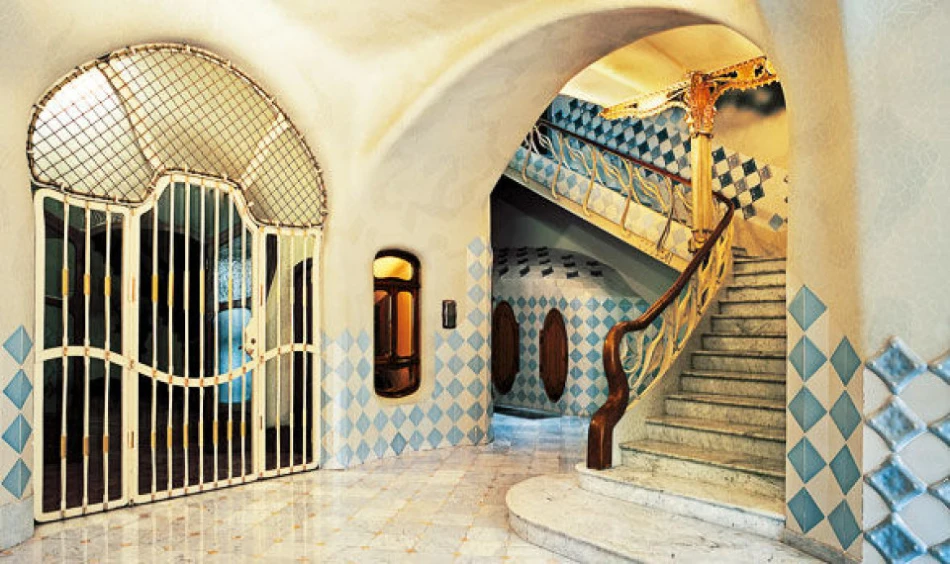
The main entrance is divided into two sections—one for the rented apartments and another for the Batlló family.
The entrance hall leading to the Batlló family’s private lounge evokes an underwater experience.
The walls feature curved vaults with skylights resembling turtle shells.
The wooden staircase railing leading to Mr. Batlló’s study resembles animal vertebrae.
Noble Floor
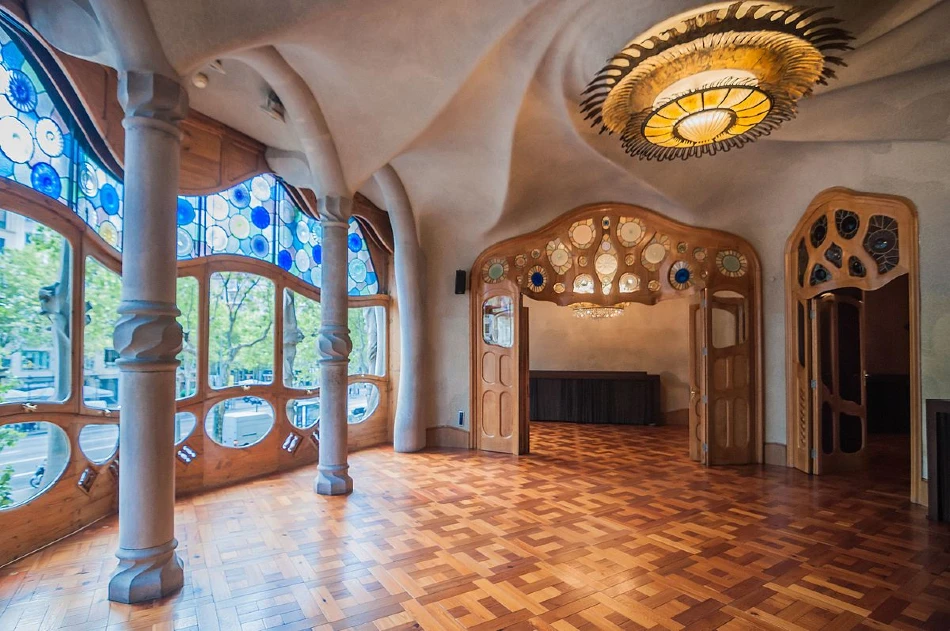
The Noble Floor is the residential area of the Batlló family and the most creatively designed space.
It has three interconnected sections—Mr. Batlló’s study, the living room, and a secluded area for courting couples.
Living Room
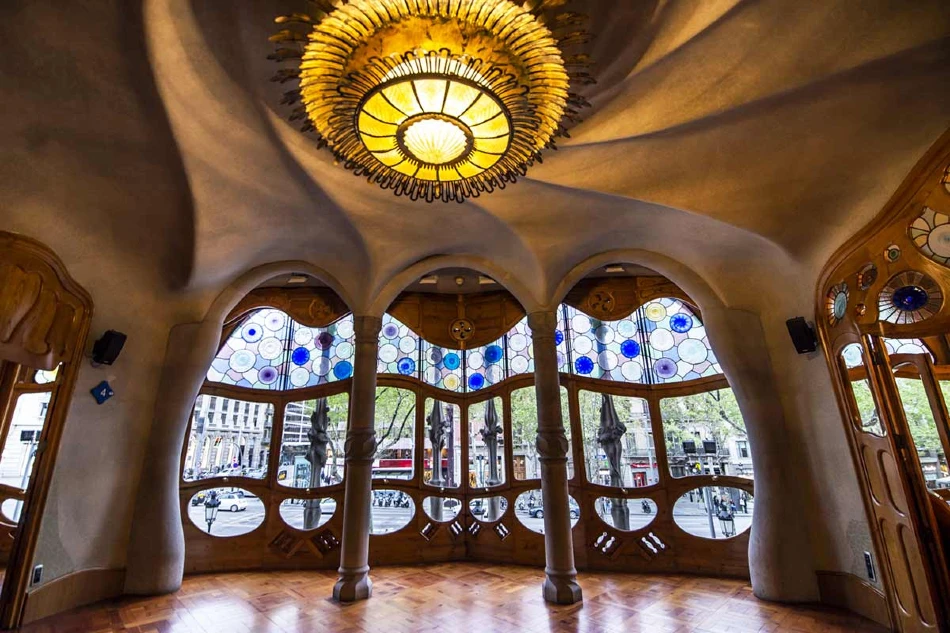
In the morning, Casa Batlló’s living room is illuminated by sunlight streaming in through huge tinted windows.
The size of these windows varies, with larger panes at the top and smaller ones at the bottom to maximize sunlight penetration.
The ceiling spirals downward like a whirlpool.
The central chandelier evokes the sensation of staring into the eye of the sea.
Courting Area
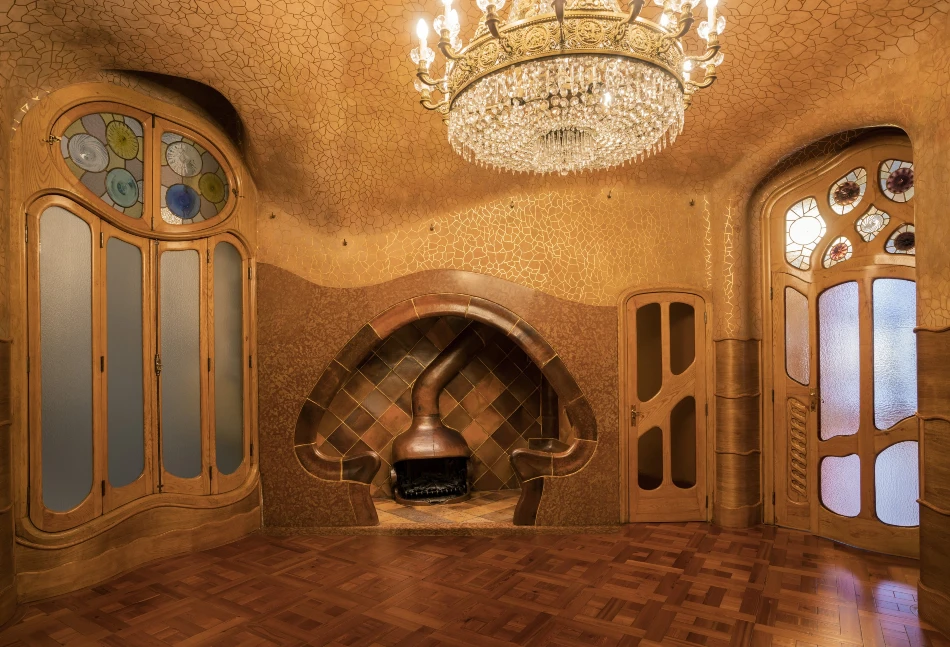
Tucked away within Casa Batlló, the courting room is a secluded retreat designed to foster sweet conversations.
Antoni Gaudí masterfully crafted this space, allowing them to escape into their own world within the grandeur of the mansion.
At the heart of the room lies its most distinctive feature—a mushroom-shaped fireplace that resembles a cozy alcove, almost like a protective shell embracing those who sit within it.
Patio of Lights
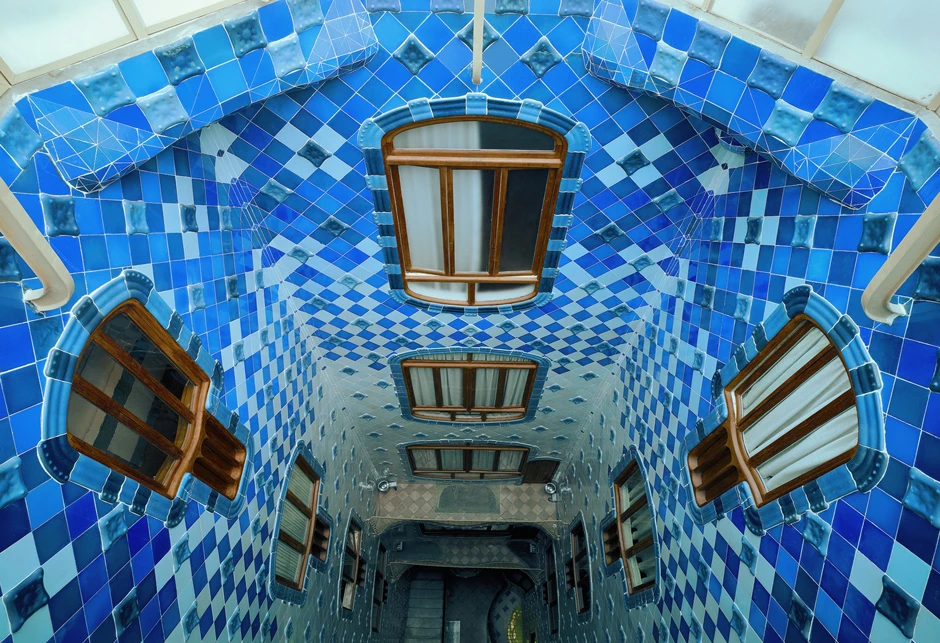
Gaudí wanted light and air to travel to all the rooms through the main skylight.
It is interesting to note the shades of blue that Gaudí used in this section.
To ensure uniform light distribution, he used darker shades of blue at the top, which gradually lightened toward the bottom.
The Loft
Casa Batlló’s loft functioned as a service area for the tenants.
Gaudí used white for this section, which housed storage areas and laundry rooms.
The sixty catenary arches resemble the ribcage of an animal.
Indoor Garden
Antoni Gaudí, a true admirer of nature, designed the Batlló family’s private garden as a tranquil retreat, allowing them to unwind in a serene, natural setting.
Seamlessly connected to their dining hall, this charming outdoor space is adorned with glass-coated flower pots, adding a touch of elegance while reflecting Gaudí’s signature organic aesthetic.
Casa Batllo’s roof
Initially built in 1877, Casa Batlló didn’t always have the exciting roof it currently has.
However, everything changed when local textile merchant Josep Batlló commissioned Antoni Gaudí to redesign his house in 1904.
Gaudí divided the building into apartments, added the fifth floor, revamped the interiors, introduced a new façade, and redesigned the roof.
The Catalan architect placed great emphasis on the roof, believing that roofs gave buildings their personalities.
Casa Batlló’s roof has four elements: the dragon’s back, the tower and cross, the four stacks of chimneys, and the terrace.
Roof in the shape of Dragon’s back

It is hard to miss that Casa Batlló’s roof is shaped like a dragon’s back. And on the dragon’s back, its spine distinctly stands out.
A small triangular window toward the right of the building represents the dragon’s eye.
Legend has it that before modern buildings obstructed the view, the Sagrada Família could be seen from this eye.
The panoramic roof consists of 600 large tiles, which resemble scales. These ceramic scales vary in color.
Near the eye, where the dragon’s body begins, the tiles are green.
They turn blue and violet in the center and pink and red toward the tail area of the dragon.
Keep this color scheme in mind, as we will discuss it again later.
The tower and Cross
A cross with four arms pointing north, south, east, and west rises from the roof’s third element, a tower.
This tower and cross seem to be inspired by nature and resemble plant life.
Golden monograms of Jesus, Maria, and Joseph decorate the tower.
If you stand in front of Casa Batlló and look up, you can’t miss Gaudí’s religious references.
Chimneys
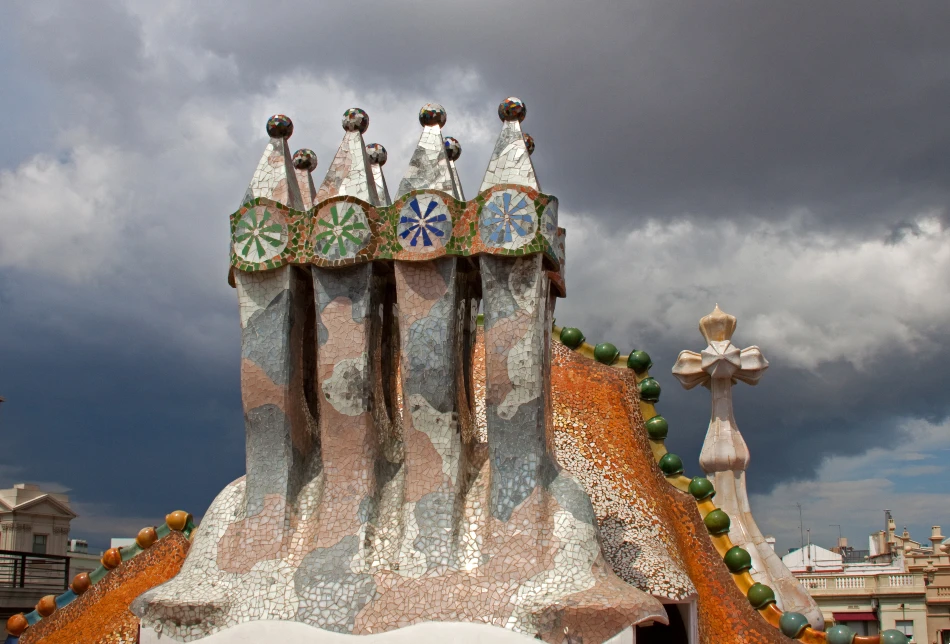
The beauty of Gaudí’s architectural ideas lay in how he combined utility and design.
He believed that functionality did not have to come at the expense of aesthetics.
The beautiful chimneys on Casa Batlló’s roof are proof of Gaudí’s philosophy.
The roof also has four stylized and polychromatic chimney stacks. Gaudí designed them to prevent backdrafts.
Gaudí’s chimneys are so famous that they serve as a backdrop for regular live music concerts on the roof.
Casa Batllo terrace
The terrace is an open space offering great views of the Passeig de Gracia.
You will also find the entrance to a small room on the terrace, which now hosts a small water fountain.
When the Batllo family lived in this house, they used the room to store water.
